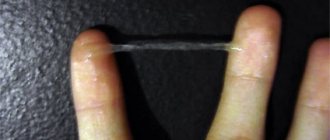Discharge from the female vagina is a natural physiological process that begins with puberty and ends with menopause. The main part of the vaginal microflora is lactic acid bacteria. They maintain an acidic environment in the vagina, which is detrimental to pathological microbes.
At different periods of a woman’s life, vaginal discharge varies and can be affected by:
- phases of the menstrual cycle;
- pregnancy and postpartum period;
- lactation;
- the presence of an intrauterine device;
- age;
- sexual behavior;
- stress;
- state of personal intimate hygiene;
- use of various chemicals;
- tight synthetic underwear;
- medications used for treatment;
- contraceptives, etc.
Depending on the main reasons listed, the quantity, transparency and density of the discharge changes. Normal discharge is clear and watery. The color is whitish or slightly yellowish. Normal discharge does not cause itching, burning or other unpleasant sensations in the vagina and external genitalia. The usual indicators of acid-base balance in women of reproductive age (and in pregnant women too) are in the range of 3.7-4.5 pH.
How does the pathology manifest itself?
Most diseases of the female genital area are accompanied by vaginal discharge, burning, itching and other unpleasant sensations.
Considering pathological discharge to be frivolous signs of gynecological diseases, many women do not go to the gynecologist and decide that the disease will go away on its own. Cases of spontaneous recovery, of course, do occur, but this happens very rarely (if the disease is nonspecific and the body has a strong immune system).
Phases of the menstrual cycle
The nature of the mucus released from the vagina depends on the exact phase of sexual intercourse. At the very beginning of the cycle, there is little secretion, it is transparent and has a watery consistency. During this period, mucus is a kind of barrier that forms in the cervical canal. This plug traps pathogenic microorganisms, preventing them from entering the uterus.
As the ovulation period approaches, the level of the hormone increases, which has an effect on the body, including the reproductive system. At this time, heavy discharge during intimacy is a common occurrence. Vaginal mucus acquires a viscous consistency and becomes alkaline. The thick lubricant takes on the smell of egg white and its color is white or cream.
When ovulation passes, vaginal secretions are released in smaller quantities. Based on the characteristics of sexual mucus, you can understand what stage of fertility is now, and whether it is possible to conceive a child. Wanting to understand what time is most successful for fertilization, you need to pay attention to the nature of vaginal mucus:
- Scanty discharge is usually observed before and after menstruation. Dryness in the vagina indicates that fertilization is impossible.
- Sticky liquid that quickly dries on the fingers indicates that sperm have little chance of survival.
- Cream-like mucus means the ovulation period is approaching. At this time, the likelihood of getting pregnant increases.
- Sticky white discharge, resembling protein, indicates a high probability of conception.
After ovulation, estrogen decreases, causing the cervical fluid to lose its ability to store semen. Other factors can also affect the nature of the lubrication:
- hormonal imbalance;
- frequent stress;
- taking medications;
- infectious diseases;
- allergy;
- gynecological diseases;
- leg diseases.
If lubricant is released in large quantities during intimacy , this does not mean that there are health problems. To determine the likelihood of conception by the volume of mucus, you need to insert two fingers deep into the vagina, remove them and evaluate the fluid. The vaginal method can be informative only if there are no gynecological pathologies.
Often, strong discharge during sex indicates bacterial vaginosis. They may have a yellowish, greenish or off-white tint. The liquid smells like rotten fish. During intimacy, itching and burning may occur.
White mucus of a cheesy consistency with the smell of kefir is most often a sign of thrush (candidiasis). Foul-smelling discharge during sexual intercourse may indicate the presence of sexually transmitted diseases such as syphilis, gonorrhea, and chlamydia.
If after sexual intercourse a woman experiences a lot of lubrication, then such secretion may be due to mixing of vaginal discharge and male sperm. Often this mixture has a yellowish tint and smells like egg white. As a rule, the liquid does not cause any discomfort.
Heavy discharge during intimacy may be associated with female hypersensitivity. Then this phenomenon is not due to pathology. A small amount of lubricant during sexual intercourse may indicate changes in the acid-base balance or disrupted microflora. Sometimes there is no lubrication at all; the most common reason for such dryness is hormonal imbalance.
Colpitis (vaginitis)
A fairly common disease, it occurs in 60% of cases when a woman notices pathological discharge. Inflammation of the vaginal mucosa can occur as a result of various infections (specific colpitis, which is more common in women of reproductive age) or a number of other reasons (nonspecific colpitis, resulting from the entry of opportunistic microflora from the gastrointestinal tract into the vagina).
The disease can occur even in little girls due to poor hygiene, in pregnant women, and in women after menopause (due to the natural aging processes of the body). Types of colpitis vary depending on the cause, each has certain clinical manifestations and differences.
Regardless of the type of disease, treatment is MANDATORY!
There are:
- Trichomonas colpitis. Caused by protozoa - Trichomonas. They are transmitted through unprotected sexual intercourse, through personal hygiene items (never use someone else's second-hand underwear, towels, etc.).
- Candidiasis colpitis. Occurs when fungi multiply and exhibit pathological activity; infection occurs through unprotected sexual intercourse; if your immune system is weakened. It manifests itself as itching and burning in the area of the external genitalia, swelling of the labia. Discomfort intensifies after urination, the amount of discharge increases noticeably.
- Atrophic colpitis. May appear when the hormone estrogen decreases. A woman feels itching, burning, dryness, yellowish vaginal discharge, and sexual frustration.
- Aerobic (nonspecific) vaginitis. This disease is accompanied by the proliferation of aerobic microorganisms that require oxygen to function. It begins when the amount of beneficial microflora decreases. It occurs mainly in girls and postmenopausal women. This is due to the hormonal characteristics of these age groups - low concentrations of estrogen. The main pathogens are Escherichia coli, enterococci and staphylococci. Infection is possible through poor personal hygiene, wearing tight synthetic underwear, thongs, or anal sex. A woman feels itching, burning, and yellowish discharge from the vagina. With the disease, the risk of inflammation of the uterine appendages increases, and complications during pregnancy may occur.
- Bacterial vaginosis. It may manifest itself as copious white or gray discharge with a specific fishy odor, itching, burning, pain during sexual intercourse, and burning during urination. Symptoms occur in women who have changed sexual partners, are taking medications, or have decreased immunity. It is a proven fact that the causative agent of bacterial vaginosis is an association of different microorganisms. In 40% of patients who initially present with this diagnosis, upon examination, ectopia of the cervix, ectropion or cervicitis is discovered.
Vaginal discharge of a pathological nature
A girl’s vaginal discharge appears with a noticeable increase in mucus if the body is affected by infectious bacteria. In this case, certain symptoms arise, which are characterized by a change in the color of the discharge and the formation of unpleasant odors. The consistency of the mucus changes, and the woman feels great discomfort in the form of burning and itching.
Such circumstances require timely assistance from a specialist to find out the cause of the disorder and provide the correct treatment. In medical practice, several abnormal deviations are noted that affect the reproductive structure and at the same time provoke the formation of a serious disease with symptoms in the form of white discharge:
Bacterial vaginosis
(Occur against the background of the growth of a pathogenic microorganism, as a result of which the balance in the vaginal environment is disrupted. During sex, the chance of infection with vaginosis increases. The disorder is determined by the presence of whitish or grayish discharge during sexual intercourse. The discharge has an unpleasant odor, which intensifies after intimacy).
Trichomoniasis
(Arises from the simplest bacterium Trichomonas, its spread occurs during sexual intercourse. The microorganism can enter the environment through hygiene items (wet towels). The pathology is manifested by white and yellow discharge with an unpleasant odor. A woman may experience inflammation of the genital organ and itching in the vagina ).
Yeast infections in the vagina
(As a rule, every woman has yeast in her vagina in small quantities. The formation of a yeast infection occurs when there is an excess of yeast. This is due to a change in the acid composition in the genital organ. Symptoms are expressed in the form of an increase in vaginal discharge during sex. The discharge has a cheesy consistency The woman also develops redness of the labia and severe itching in the vagina).
Brown discharge
It happens that a few days before the start of menstruation, a woman has brown discharge from her vagina. They talk about the presence of blood in them.
Bloody discharge is possible due to mechanical damage to the mucous membrane and may be accompanied by symptoms:
- pain in the genital area;
- discomfort during sex;
- swelling;
- hyperemia of the external genitalia.
The cause of brown discharge before the onset of menstruation may be hyperplasia of endometrial polyps; after sexual intercourse - cervical cancer and background processes.
Mucus from the vagina during sexual intercourse of a non-pathological nature
Discharge in women during sexual intercourse is a combination of natural fluid and cellular structures that are produced by body systems. Such structures are transparent bases and are similar to the mucus that forms during ovulation. After the ovulation period, during sexual intercourse, women experience white and thick discharge. The color and consistency of vaginal mucus is formed depending on the age of the patient and how active her intimate life is.
Hormonal changes, medication use, and the presence of an infectious disease in the body also affect such signs. With sexual arousal and intercourse, an increase in vaginal secretion occurs. This is necessary to provide lubrication to the penis.
Diagnostics
Only a doctor can establish an accurate diagnosis of clinical signs during examination and the necessary laboratory and instrumental examinations:
- smear on vaginal microflora;
- tests for STDs, ELISA, PIF;
- Ultrasound of the pelvic organs;
- general clinical blood and urine tests.
If inflammatory discharge recurs:
- it is necessary to undergo cultures to determine the sensitivity of microorganisms to previously prescribed drugs;
- Ultrasound of the pelvic organs;
- general clinical blood and urine tests.
Features of discharge during excitement
During intimacy, the vagina most often becomes moisturized. And the more the attraction to a sexual partner intensifies, the more intense the lubricant is released. This is a colorless, odorless mucus.
As a rule, women produce about 5 ml of lubricant per day. With increasing excitement, the secretion begins to be produced more intensely. This is achieved due to the rush of blood to the vaginal walls and stimulation of the sex glands. Discharge during sex can be scanty or copious. Typically, the most lubrication is released at the moment of peak pleasure.
Such a secret simultaneously performs several important functions; it allows you to:
- make sex more comfortable by facilitating insertion and sliding;
- minimize the entry of foreign microorganisms, forming protection against germs and infections.
Lubricant also helps create a suitable environment for sperm during the fertile period. This increases the chances of conception.










